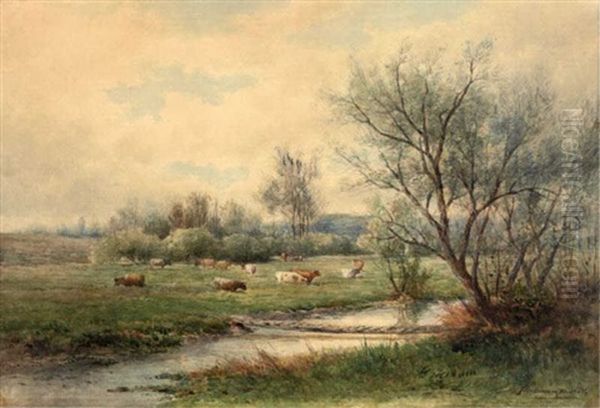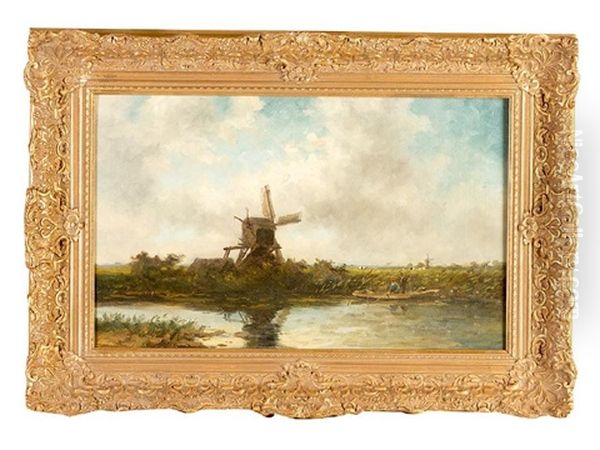
Hendrik Dirk Kruseman van Elten stands as a notable figure in nineteenth-century art, a painter and etcher whose career gracefully bridged the artistic traditions of his native Netherlands and his adopted home in the United States. Born in Alkmaar, Netherlands, on November 14, 1829, and passing away in Paris, France, on July 12, 1904, his life spanned a period of significant change and development in Western art. Known primarily for his evocative landscape paintings and his technically proficient etchings, Kruseman van Elten navigated the currents of Romanticism and Realism, leaving behind a body of work appreciated on both sides of the Atlantic. His journey reflects the broader patterns of artistic migration and cultural exchange that characterized the era.
Early Life and Artistic Formation in the Netherlands
Kruseman van Elten's artistic journey began in the historic city of Haarlem, a center with a rich artistic legacy dating back to the Dutch Golden Age. His formal training commenced under the guidance of Cornelis Lieste (1817-1861), a respected landscape painter known for his detailed and atmospheric depictions of Dutch scenery. Lieste's influence likely instilled in the young artist a deep appreciation for the nuances of the Dutch landscape and the importance of careful observation.
Furthering his education, Kruseman van Elten attended the Haarlem City School for Drawing (Stads Teekenschool) between 1845 and 1849. Here, he studied under Jan Reekers (1824-1895), who provided instruction in drawing, a foundational skill for both painting and printmaking. This period was crucial for honing his technical abilities and developing his artistic eye.

Haarlem's vibrant artistic environment also provided opportunities for interaction with peers. He received instruction from Pieter Frederik van Os (1808-1892), an artist known for his landscapes often featuring cattle, continuing a family tradition of animal painting. During his studies, Kruseman van Elten formed significant friendships with fellow students who would also achieve recognition. Among these were Paul Joseph Constantin Gabriël (1828-1903) and Johannes Warnardus Bilders (1811-1890). Both Gabriël and Bilders (along with Bilders' son, Gerard Bilders) would later become associated with the Hague School, a pivotal movement in Dutch Realism. These early connections placed Kruseman van Elten within a network of emerging talent focused on renewing the Dutch landscape tradition.
Developing a Career in Europe
After completing his initial training, Kruseman van Elten began to establish himself as a professional artist. Between 1853 and 1861, he divided his time between Amsterdam, the bustling commercial and cultural heart of the Netherlands, and Utrecht, another city with a significant artistic heritage. This period likely saw him refining his style, exhibiting his work, and seeking patronage. His focus remained steadfastly on landscape painting, capturing the distinctive flat horizons, waterways, and atmospheric light of his homeland.
His artistic ambitions extended beyond the Netherlands. He embarked on travels through Germany, Switzerland, and Austria. These journeys exposed him to different terrains, from the rolling hills of Germany to the dramatic vistas of the Alps. This experience broadened his visual repertoire, allowing him to incorporate a greater variety of natural forms and atmospheric effects into his work, moving beyond the typically Dutch subjects of his early training.
Seeking further engagement with the European art world, Kruseman van Elten spent time in Brussels. While there, he became involved with the local artistic community and was noted as a member of the Société Royale Belge des Aquarellistes or a similar artists' association. Brussels, at the time, was an important artistic crossroads, and his participation in its societies indicates his growing reputation and his desire to connect with artists beyond Dutch borders. This period reflects his integration into the broader currents of European landscape painting.
Emigration and Success in America
In 1865, at the age of 36, Hendrik Dirk Kruseman van Elten made a life-altering decision to emigrate to the United States, settling in New York City. This move coincided with a period of great artistic energy in America, particularly in landscape painting, dominated by the later phase of the Hudson River School. New York was rapidly becoming the nation's premier art center, attracting artists from both America and Europe.

Kruseman van Elten quickly integrated into the New York art scene. While he continued to paint, he increasingly turned his attention to etching, a medium experiencing a significant revival during the latter half of the nineteenth century. His European training and technical skill served him well, and he gained recognition as a talented printmaker alongside his established reputation as a painter.
His landscape subjects expanded to include American scenery. While trained in the Dutch tradition, he adapted his skills to depict the landscapes of the northeastern United States, particularly New England and New York State. Works like Mount Lafayette from Coffin Pond (1868), an oil painting, demonstrate his engagement with the American wilderness, a theme central to the Hudson River School. Though perhaps less focused on the sublime grandeur favored by artists like Albert Bierstadt (1830-1902) or Frederic Edwin Church (1826-1900), his American works retain a sensitivity to light and atmosphere characteristic of his Dutch background.
He exhibited his work regularly in prominent American venues, including the National Academy of Design in New York and the Boston Art Club. His participation in exhibitions, such as the "Third Annual Exhibition of Selected Works from the Studios of Artists of New York," where his painting Moonlight (depicting a New Jersey scene) was shown, solidified his presence. He found a receptive audience and market for both his paintings and etchings in America.
Master of the Etching Needle
While accomplished as a painter, Kruseman van Elten earned particular distinction in America as an etcher. His arrival coincided with the burgeoning Etching Revival, a movement that championed etching not merely as a reproductive technique but as an original expressive medium. Artists in Europe, like James Abbott McNeill Whistler (1834-1903) and Sir Francis Seymour Haden (1818-1910) in England, and Félix Bracquemond (1833-1914) in France, were elevating the status of the medium.
Kruseman van Elten became a key figure in the American branch of this revival. He was an active member of the New York Etching Club, founded in 1877, which played a crucial role in promoting original printmaking in the United States. His technical mastery, honed through his European training, allowed him to create etchings of remarkable detail, subtlety, and atmospheric depth.
His etching On the Shepang River, Connecticut (1880) is a prime example of his work in this medium. Measuring approximately 9 by 5.5 inches, it captures a tranquil river scene with delicate linework and nuanced tonal variations. The fact that such works were sometimes given as gifts, as this one reportedly was for a wedding, speaks to the appreciation of fine etchings as works of art in their own right during this period. His etchings often depicted pastoral landscapes, woodland interiors, and river views, rendered with a sensitivity that balanced detailed observation with poetic feeling.
His etching work wasn't limited to American scenes. He also produced prints based on European subjects, sometimes revisiting sketches from his earlier travels or depicting scenes from his homeland. An interesting example is the etching Hunebed te Valthe, which depicts a prehistoric dolmen (a megalithic tomb) in the Drenthe province of the Netherlands. This work connects to his contribution of illustrations for the Dutch author Willem Jacobsz. Hofdijk's (1816-1888) book Ons Volksbestaan (Our People's Existence), where he depicted scenes of prehistoric life. This interest in historical and archaeological subjects adds another dimension to his artistic output.
Artistic Style and Thematic Concerns
Kruseman van Elten's artistic style evolved over his long career but remained rooted in the traditions of landscape representation. His Dutch training provided a foundation in careful observation and rendering of natural detail, characteristic of painters like Lieste and Van Os. His work often displays a meticulous approach to depicting trees, foliage, water, and rock formations.
His style incorporates elements of both Romanticism and Realism. The Romantic sensibility is evident in his attention to atmosphere, light effects (like moonlight or the golden light of late afternoon), and the evocative mood of his scenes. However, this is tempered by a Realist's commitment to accurately portraying the specific character of a place. He avoided excessive dramatization, preferring quieter, more intimate views of nature.
His subject matter was diverse, reflecting his travels and dual residency. He painted classic Dutch polders, windmills, and canals. His European travels yielded depictions of German forests and Alpine scenery. In America, he captured the rivers, lakes, and mountains of New England and the surrounding states. Works like Landscape with Cow show his continuation of the pastoral tradition, while paintings featuring orchards in bloom reveal his sensitivity to seasonal beauty.
Whether working in oil or etching, Kruseman van Elten demonstrated a consistent interest in the interplay of light and shadow to define form and create mood. His etchings, in particular, showcase his ability to achieve a wide range of tones and textures using only lines. His compositions are generally well-balanced, often employing traditional landscape structures but rendered with a freshness derived from direct observation. He successfully blended the detailed finish favored by some Dutch traditions with the broader atmospheric concerns emerging in nineteenth-century landscape art, influenced perhaps by the Barbizon School painters in France, such as Jean-Baptiste-Camille Corot (1796-1875) or Charles-François Daubigny (1817-1878), whose work was becoming internationally known.
Later Life and Legacy
Around 1870, Kruseman van Elten made a brief return visit to Europe, suggesting continued ties to his homeland. However, he remained based in New York for over three decades, becoming a fixture in the American art world. His long tenure in the United States distinguishes him from many European artists who only visited briefly. He participated actively in the artistic life of New York, contributing to exhibitions and organizations like the New York Etching Club.
In 1897, after living and working in America for 32 years, Kruseman van Elten decided to return to Europe permanently. He chose Paris, then widely considered the capital of the art world, as his final home. The reasons for this move late in life are not explicitly documented but may have involved a desire to reconnect with European art developments or simply to retire in a major cultural center. He passed away in Paris in 1904.
Hendrik Dirk Kruseman van Elten occupies a unique position in art history as a transatlantic artist. He successfully navigated the art scenes of both the Netherlands and the United States, adapting his style while retaining a distinct artistic identity rooted in his Dutch training. His influence can be seen in his contribution to the American Etching Revival, where his technical skill and dedication to original printmaking helped elevate the medium's status.
His paintings, while perhaps less revolutionary than those of some contemporaries, represent a solid and sensitive continuation of the landscape tradition. He absorbed influences from Dutch Romanticism, the Hague School's precursors, and aspects of the Hudson River School's aesthetic without fully belonging to any single movement. His contemporaries included not only his early Dutch friends like Gabriël and Bilders, but also prominent American landscape painters like Sanford Robinson Gifford (1823-1880), Jasper Francis Cropsey (1823-1900), and Asher B. Durand (1796-1886), whose work formed the backdrop against which he established his American career. His association with Albert Bierstadt is also noted. Furthermore, his etching work places him in the context of international figures like Whistler and Haden, as well as American etchers like Thomas Moran (1837-1926) and Mary Nimmo Moran (1842-1899).
His works are held in various museum collections, ensuring his legacy endures. He is remembered as a skilled and dedicated artist whose career reflects the interconnectedness of the nineteenth-century art world, successfully bridging European tradition and American artistic development, particularly in the realm of landscape painting and etching. His long career and consistent output provide valuable insight into the artistic tastes and practices of his time on both continents.